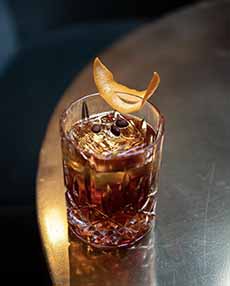|
What do you do when your cocktail arrives with a bit of citrus peel?
It can be lemon, lime or orange peel, depending on the drink.
Do you:
Ignore or discard it?
Rub it around the rim of the glass?
Eat it?
Its a good idea to rub the rim, as is done with a cup of espresso. It leaves an invisible coat of the citrus oil, which will add flavor to the drink with every sip you take.
We love the flavor of the essential oils in the peel (close to zero calories).
We also admit to eating the peel. Its a habit we picked up in college, when draining our drink to the last drop. With a limited budget, when no liquor was left we stretched the drink by working on the ice cubes and the peel.
HOW TO CUT PEEL FOR A GARNISH
Different bartenders take different approaches:
Curl: a long, slender strip is peeled with a channel knife and then twisted into a curl/spiral (photo #3).
Strip: A wide oblong is cut from the citrus and dropped into the drink. Sometimes, the mixologist cuts designs into the strip with a channel cutter.
Twist: The classic piece of peel, an oblong typically given a quick twist and tossed onto the top of the drink (photo #1).
Wedge: A garnish that cuts a wedge from the entire lemon, served with drinks and foods. Its to squeeze into the drink/over the food, for some fresh lemon flavor. It can be dropped into the drink or sit on the rim (photo #5).
Wheel: A wheel is a circle cut vertically through the lemon. It has both the flesh and the rind with the peel. It can be notched to sit on the rim (photo #4) or tossed atop the drink.
Zest: Use a 5-hole zester for long, slender stripsnot grated zest but a slender julienne (photo #2).
And now, the rim strip.
Whats a rim strip? Its name we gave to the orange peel in photo #1.
We saw it for the first time last week, when we reviewed Mr. Black Espresso Liqueur.
Instead of cutting a strip of peel for a twist and tossing it into the drink, some clever mixologist cut a slit on the bottom of the strip so the peel could sit on the rim.
We havent seen this trick before, and we love it. Its so much more elegantand funthan the classic twist.
Depending on your perspective, it can look like a quarter-moon, a hammock or a Chinese sampan.
Try it with your next peel garnish.
THE BENEFITS OF CITRUS PEEL
Most people use only the juice and flesh of the lemon, and throw away the peel.
We suggest that before you juice the lemon, zest it. Save the zest for everyday cooking, for perking up marinades, salads, salad dressings, sauces, sorbet and vegetables to flavoring a glass of water.
If we have no immediate use for the zest, we use it to flavor ice cubes (fill the ice cube tray, then add some zest to each section.
Here are the health benefits of the peel:
High in fiber and antioxidants, including vitamin C and D-limonene, the essential oil in the peel. It has been shown to possess anti-inflammatory, antioxidant, anti-stress, and possibly disease-preventing properties.
It has small amounts of calcium, potassium and magnesium.
A piece of peel has negligible calories.
Here are more reasons to eat the peel.
To your health!
|
|

[1] Look closely at this Black Negroni: A slit enables the peel to sit on the glass rim (photo Mr. Black).

[2] Lemon zest and a basil leaf garnish this Blackberry Bramble (photo Sugar Cane Raw Bar & Grill | Miami | Las Vegas | Brooklyn).

[3] A Cosmopolitan with a lime curl (photo Heathman Restaurant & Bar | Portland, Oregon).

[4] A Margarita with a lime wheel (photo Tequila Avion).

[5] Old Fashioned with a lime wedge (photo Makers Mark).
|





